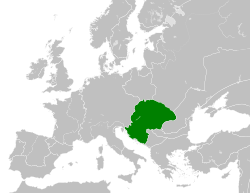უნგრეთის სამეფო
უნგრეთის სამეფო — მრავალენოვანი და მრავალეროვანი სახელმწიფო ცენტრალურ ევროპაში,[2] ის მთლიანად მოიცავდა დღევანდელ უნგრეთს, სლოვაკეთს, ტრანსილვანიას, იმიერკარპატეთს, ბურგენლანდს ასევე ვოივოდინას და ხორვატიას ისტრიისა და დალმაციის გამოკლებით. 1102 წლიდან ის მოიცავდა ხორვატიის ტერიტორიასაც. სამეფომ იარსება თითქმის ათასი წელი 1000–დან 1946-მდე, და წარმოადგენდა ევროპის ერთ-ერთ კულტურულ ცენტრს.[3]
იხილეთ აგრეთვე
რედაქტირებალიტერატურა
რედაქტირება- Frucht, Richard. Encyclopedia of Eastern Europe: From the Congress of Vienna to the Fall of Communism (2000) online edition
- Hoensch, Jörg K., and Kim Traynor. A History of Modern Hungary, 1867–1994 (1996) online edition
- Hanak, Peter et al. A History of Hungary (1994)
- Kontler, Laszlo. A History of Hungary (2006) excerpt and text search
- Molnár, Miklós, and Anna Magyar. A Concise History of Hungary (2001) excerpt and text search
- Palffy, Geza. The Kingdom of Hungary and the Habsburg Monarchy in the Sixteenth Century (East European Monographs, distributed by Columbia University Press, 2010) 406 pages; Covers the period after the battle of Mohacs in 1526 when the Kingdom of Hungary was partitioned in three, with one segment going to the Habsburgs.
რესურსები ინტერნეტში
რედაქტირებავიკისაწყობში არის გვერდი თემაზე:
სქოლიო
რედაქტირება- ↑ Adeleye, Gabriel G. (1999). World Dictionary of Foreign Expressions. Ed. Thomas J. Sienkewicz and James T. McDonough, Jr. Wauconda, IL: Bolchazy-Carducci Publishers, Inc. ISBN 0-86516-422-3.
- ↑ Gerhard Stickel: National, Regional and Minority Languages in Europe
- ↑ Mario D. Fenyo. Literature and Political Change: Budapest, 1908–1918: Transactions of the American Philosophical Society, 1987. Books.google.com.au.


